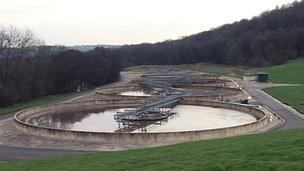Work starts on Bradford's human waste power plant
- Published

The plant could be up and running by 2013
Work has started on the construction of a power plant on the outskirts of Bradford that will convert human waste into electricity.
The £30m project will power an entire sewage works at Esholt by 2015.
Yorkshire Water, which is building the plant, hopes to save up to a third from its annual £45m energy bill.
The 750-acre sewage works treats up to 300 litres of waste water a second before discharging it into the River Aire.
As a result, about 26,000 tonnes of sludge is produced at the site each year, which the company disposes via an on-site incinerator.
The power plant will use anaerobic digestion (AD) technology, which breaks down waste into gas which is then burnt to produce heat and electricity.
The plant is expected to be the biggest of its kind on an urban site in the UK, the water company said.
Ben Roche, manager of energy and carbon at Yorkshire Water, said: "Each year we receive an overall electricity bill for approximately £45 million with 70% of our carbon footprint coming from electricity - a footprint that currently stands at 453,000 tonnes of CO2.
"At the moment we already generate a third of the energy we use on site at Esholt through renewable energy technologies, but our aim is for this huge facility to become fully energy self-sufficient by 2015.
"In addition, this pioneering technology will enable us to save around £1.3m a year at this site alone which will help us in turn to keep customers' bills as low as possible."
The plant will take about 18 months to complete and is expected to be up and running by early 2013.
- Published2 December 2011
- Published6 September 2010